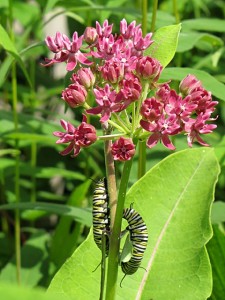Mariton: Butterflies and Milkweed
by Tim Burris, Preserve Manager
Our Butterfly Walk was rained out on Tuesday, but a couple people were able to reschedule on Wednesday morning. I looked at my “To Do List” and the pile of work on my desk and almost opted out. Carole and Virginia are pretty persuasive.
The Milkweed is blooming well and we saw several species of butterflies. Milkweed is well known as a food plant for Monarch butterflies, chemicals in the leaves are ingested by the caterpillars making them (and the later stage butterflies) unpalatable to birds. The Monarch’s orange and black markings are a warning sign for birds to hunt somewhere else.

Carole Mebus photographed two Monarch caterpillars feeding on this Swamp Milkweed (Asclepias incarnata). Interestingly, this plant is far from any water, but it is beautiful.
While milkweed is associated with Monarchs, there are lots of butterflies (and other pollinators) that visit the blossoms for nectar. At Mariton, the milkweeds don’t bloom all at once. Rather, plants are in bloom somewhere in the meadows continuously for a month or more. Meaning we have a changing palette of butterflies as different species emerge and feed at the flowers.
We saw frittillaries, swallowtails, skippers and hairstreaks on our walk. So far, it has been a great year for butterflies, and I expect to see lots more species next week on our walk.
